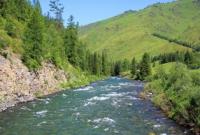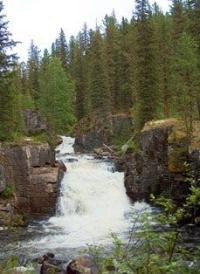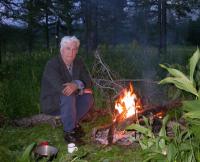You are here
Excursion to Markakol lake and Bukhtarma valley.






Tour of Altai.
“Almost against us, from the same sheer cliff, the entire mass of water of the Arasanka River was torn off and rushed down with a deafening roar, breaking into neighboring rocks and turning into white foam and small splashes ... In mute delight, stunned by roar and noise, we looked at the whole this frothy mass ... We were very wet from the spray of water, a strong air movement made us choke and gasp ... we returned to the keys, taking the memory of a grandiose phenomenon of nature and feeling like heroes for life”
Remembering the participants of the hiking.
Hiking in the Kazakhstan Altai.
It is unlikely that anyone who knows the East Kazakhstan region will deny that Lakes Zaysan and Markakol, Rakhmanovskie Klyuch and the Bukhtarma River are the most beautiful corners of Kazakhstan Altai. Admiring the picturesque landscapes and wildlife, nature watchers comfortably drive this entire route for a week and a half by car.
But one can imagine what difficulties stood in this way 100 years ago, when there were no roads, no cars themselves, and almost the only vehicles were riding horses. And all the more surprising that in 1909, pupils of the 8th form of the Semipalatinsk gymnasium passed along this route, and even grabbing the foot of the Belukha.
A desperate journey! Girls of sixteen years old, who have no travel experience, on horseback had to cross over turbulent mountain rivers (it was in this, in 1909, that the geologist Petz was killed when crossing the Khair-Kumin river), traveling taiga paths along mountain ranges, hundreds of kilometers, and then rafting on the Bukhtarma.
And the girls do not even call their heroic tour neither a journey, nor a camping trip, but merely an excursion! (See Notes of the Semipalatinsk Branch of the Russian Geographical Society, Issue VI “Excursion to Altai pupils of the Semipalatinsk girls’ gymnasium in 1909”). However, look at Dahl, then the word "tourist" did not exist.
But it was like that. The idea of a trip to Altai belonged to geography teacher F.R. Dulsky (incidentally, an active member of the Semipalatinsk Branch of the Russian Geographical Society), and was warmly supported by a group of high school students.
But stupid cool ladies met with hostility: this is crazy all summer riding horses, in men's suits riding in the taiga! However, everything settled down and even the Governor-General supported, having assisted. They raised money by staging an amateur play, and a sponsor was found - the Verkhne-Irtysh Shipping Company, which offered to take it to Lake Zaysan for free.
They looked forward to spring, sewed costumes, prepared camping equipment. And exams were passed, excursionists led by their leader F. Dulsky on the steamboat “Rus” set off up the Irtysh. The first stop was in Ust-Kamenogorsk, where they made an excursion to the apiary of the famous amateur beekeeper A.N. Fedorova.
Another two days sailed along the Irtysh, admiring the mountains along the banks of the river. On the third day the Irtysh parted, and the expanse of Lake Zaysan appeared; they sailed on it until 4 pm, when they saw a low Cape Topolevoy with fragile fishing huts on a deserted coast.
They did not spend the night in the village because of countless hordes of mosquitoes, and drove all night in carts to the city of Zaysan. The town consisted of 8 streets and made a good impression thanks to the irrigation canals with murmuring water and poplars planted along the line of houses.
Here, sitting in the empty classrooms of the school, we lived for two days. We went to the gorge of the Dzhemineyki river, visited the Cossack camp, guarding the Russian-Chinese border. Almost the main attraction of Zaysansk was the local amateur naturalist A.S. Khakhlov, who was friends with many travel scientists who visited his city, and corresponded with some zoological institutions in Russia. Girls examined his collections of birds, insects, as well as white mice and guinea pigs living with him.
The next two days we drove through the deserted, dune steppe, heading towards the Irtysh. The local steppe was struck by the lack of people and the abundance of sand, in which horses and carts were stuck, and therefore most of the way had to be walked.
Having crossed the Black Irtysh by ferry, the girls stopped in the Kaljir volost house on the site of the current Buran. There were then such volost and zemstvo houses - hotels in almost every village for official business travelers.
The steppe once cultivated by farmers was spread around, and now it is deserted, overgrown with chies and bushes of tereskena. Here I had to make a stop for a few days, because we hired horses, and then learned to ride them, having made a test trip to the mountains along the gorge of the Kaljir River.
We drove along narrow paths above a steep, high shore, and when wading crossed Kaljir, the head of the campaign congratulated the girls on the successful passing of the exam for suitability for mountain hikes.
The further path ran along the foothill valley to Alekseevka. The steppe turned green, motley with motley grasses, the area revived. In the village they wanted to stay in the zemstvo hut, but it was so small that I had to pitch a tent.
The landscape was changing: on the right, behind the border Alcabek, huge dunes of yellow sand rose already in China, on the left the path to Markakol led through stony mountains. If before tourists were surprised at the poverty of the Priisan desert, now they were amazed at the luxury of mountain nature.
The mountains became steeper, the trail became more dangerous, and then clouds were thickening and it started to rain. The horses stumbled, glided and fell, and one horse could not take a particularly steep climb. While messing with him it got dark and had to set up camp.
Everyone got wet, froze, they had to go to bed, and the bonfire did not flare up due to dampness and continued rain. The closer we approached the lake, the more beautiful the landscapes became. Entire seas of swimsuits, lilies, and aquilegia alternated with cedar forests and larch groves.
And in the gleams of the red-trunked pine trees, a light blue lake flashed. It lay with a sparkling mirror among the mountains covered with coniferous forests. In the village of Urunhayke, where we stayed in a forester’s house on the very shore of the lake (apparently, on the site of the current reserve - A.L.) there were only eight huts.
For two days that they lived here, the weather was fine, and the girls admired the lake, boated and gathered plants for the herbarium. From here, having hired a local guide, through the taiga and mountains they moved to Katon-Karagay.
The path meandered, winding along the river, then ups and downs began in the mountains, where snow still lay and cold streams ran. Again wet in the rain, a terrible thunderstorm found in the evening before spending the night in a cold and damp gorge.
And the next day, climbing the Sarym-Sakty ridge, we saw the Bukhtarma valley and the villages of Chernovaya and Chingistai. The descent was steep and dangerous and passed through the rubble of rocks and dense forest; overcoming dangerous areas, broke free and spent the night in Chingistay.
In Katon-Karagai we stopped at a local school, here we paid off the guide and for the horses, paying 120 rubles, and hired a new shift along with the guide Arimbimbay. From Katon-Karagay, the coast of Bukhtarma, tourists moved to the Rakhmanovskie keys.
On the way to Berel, we spent the night in the house of a rich maralovod Belousov, whose rooms were littered with soft branchy horns of maral. From Bereli began a difficult and very steep climb to Arasan. The weather improved, the clouds dispersed and the travelers had a view of the two-headed beauty Belukha.
The descent was even more difficult and most importantly riskier than the ascent. The path went along the stream, and the horses kept slipping and injuring their legs. One of them got stuck among the boulders and was barely rescued from trouble.
Having crossed the Arasanka river, the travelers were finally at their destination, having made 40 miles in a day. Here is how one of the girls described the then resort Rakhmanovskie keys or Arasan: “The place where the warm key is knocked to the surface of the earth is surrounded by a fence, inside of which huts for patients and all the few buildings of the“ resort ”are huddled.
A lot of patients come here, and often they end their life here, which is greatly facilitated by the sharp fluctuations in air temperature inherent in mountainous places. "The next day, in the morning, the excursion moved to Rakhmanovsky waterfall, and all the healthy inhabitants of the resort joined it.
The terrain here was truly wild. Horses fell from the stones and fell, now and then had to wade between the rubble of stones and fallen trees. But after 8 miles of the journey, travelers were able to enjoy an unprecedented spectacle.
Cautiously, holding on to the bushes, the girls crawled to the edge of the cliff and looked down: “Almost against us, the whole mass of water of the Arasanka River was torn off from the same steep cliff and rushed down with a deafening roar, breaking into neighboring rocks and turning into white foam and small ones splashes.
In mute delight, deafened by roar and noise, we looked at all this frothy mass ... From the splashes of water we were very wet, the strong air movement made us choke and suffocate ... we returned to the keys, taking away the memory of a grandiose phenomenon in our souls and nature and feeling like heroes, ”one of the participants wrote.
After the Rakhmanov keys, the final and most difficult part of the journey began. On a steep climb, one of the pack horses flew down, turning over four times. Fortunately, everything ended well. On the pass, from where the whole view of the chain of Katunsky proteins opened, there was a pile of stones with the inscription that it was built by the famous artist - Altai Gurkin.
Ahead were several more dangerous and truly risky crossings fording through Chernaya, Belaya Bereli, and then through Katun. A new nuisance added to the difficulties of the journey: the products ran out and there was nowhere to replenish them. However, no one thought to cut the plan.
Half-starved, in an icy rain, they crossed Katun several times and stubbornly moved forward to the Belukha glaciers. Having made a hook, we got to the Rossypnaya waterfall, which seemed to them not as grandiose as Rakhmanovsky, but he had his own charm: all his water was scattered into small splashes and nowhere was visible the slightest trickle.
“Having examined the waterfall, we got wet back to the tent. There was a noise and the roar of a waterfall in my head. The clothes were dried and dressed up in fur coats, they sat down to bask around the fire. It was getting cold, but we were glad for it, because the sky cleared up and Belukha appeared before us in all its beauty, lit by the moon.
After trembling under the covers all night, at 4 in the morning we went to Belukha, taking with us a bag of crushed crackers - all our wealth. This cold beauty was shining now, illuminated by the sun, with its dazzling whiteness and brilliance.”
All this day the girls climbed the glacier, admiring the grandiose picture of the mountains, crossed streams, approached cracks, looked into the deep blue depths of the abyss. By two o'clock in the afternoon we came to the black cliffs, it was dangerous to climb further because of the steepness, rested and began to descend.
This was the final point of the route, from here the travelers turned back. While the lakes reached Katon-Karagai through Yazevoe and Maralie, there was more than one adventure: they froze, were wet in the rain, starved, and lacked sleep.
The money was almost over, so they decided to do the rest of the journey on rafts first along Bukhtarma and then along Irtysh. In Sogornaya we agreed with the rafts and plunged onto the rafts. Like everything new, swimming on the river seemed no less interesting than on horseback.
With terrible force rushes in the upper reaches of Bukhtarm and landscapes are changing continuously. In the villages where they stayed, dressed in men's suits of girls, the locals mistook it for devils, then for the Japanese, and when they got closer, they wondered why these people were just traveling around the mountains idly.
Two days before Bykovo sailed safely, but then trouble began. The water in Bukhtarma was asleep, and the raft kept aground. There was already nothing, there was no money, therefore, when once again, opposite Talovka, they ran aground, the girls could not stand it and, hiring a supply, left for Gusinaya, where the captain of the ship "Arseny" agreed to take them on loan to Ust-Kamenogorsk .
On July 25, travelers returned to Semipalatinsk.
Having been on the tour for exactly one and a half months and riding more than 700 kilometers, the tourists spent 43 rubles per person. In conclusion, the author of the article, one of the participants in Mordvinov’s campaign, complained that, due to lack of time, they didn’t do everything they planned, and collected few collections.
But after visiting the most beautiful part of Altai, they accumulated impressions for life, and any modern tourist will envy the route traveled by them.
Authority:
Naturalist writer, photo artist, local historian Alexander Lukhtanov.
Photos
Alexander Petrov.






